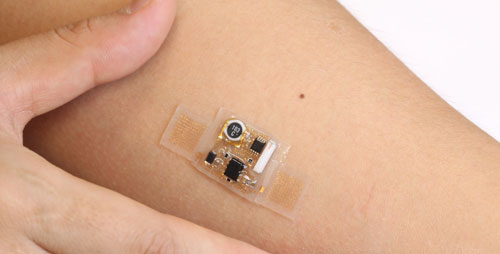After biomedical engineers from South Korea, who designed a dermal patch that monitor patient’s health and release drug under the skin, scientists from the University of Illinois at Urbana-Champaign and Northwestern University have come up with another revolutionary dermal, electronic patch that looks like a tattoo.
Unlike the health monitoring devices that can be worn on the wrist or around the waist, the new stick on patches are soft, ultra thin. The innovative patch stretches with the skin and consolidate commercial chip based wireless electronics that keep track of the health.
The patch takes the inspiration from origami and integrates specialized microfluidic design in which the wires bend and folded in a way, that make the patch flexible and easy to bend without being strained by stiff electronics parts. These provide everyday health monitoring such as EKG and EEG testing, sending data, wirelessly to smartphone or computer. Such tracking devices will eliminate the use of time taking and bulky wires, tape or pads based medical equipments.
According to a professor at the Northwestern University, Yonggang Huang, who is joined working on the project with Illinois professor Joh A. Rogers, the electronic dermal patch was designed to provide a health tracking system that operated 24/7, but did not interfere with individual’s daily activity. They soft dermal patch performs many essential tracking functions along with being comfortable, that moves and bend as per the body movement. Most importantly, the patch is wireless for easy charging and gives real time data related to health to a computer.
The scientists compared the traditional health monitoring equipments as EKG and EEG with the new age wireless dermal patch and found the dermal patch performance was at par with traditional equipments and were also far convenient for the patients. Such elements are important for continual monitoring, in circumstances as sleep studies or stress tests where the results are based on the mobility of the patients or for premature babies with delicate skin.
To create chip scale wearable gear, the team accordingly, needs to re-compose batteries, capacitors and other constituents of the gear. And the team used new concept which integrates microfluidics with origami, which allowed compatibility with commercial off the shelf components for improvement, reduced expense and increases option in device variety.
The soft microfluidic designs enabled the team to blend relatively big, bulky chips to the soft, flexible base of the patch. The patch is made of thin, flexible, fluid filled envelope. The various chip parts are attached to minute, elevated support points, which allow the parts to bond with the patch lying below and at the same time making the patch flexible to stretch and move.
The various electronic parts of the patch such as power inductors, radios and sensors and so or are connected by tiny wires arranged like origami. Such arrangement of the wires can readily adjust as per the body movement, making the patch flexible and allowing it to easily twist, bend or stretch and so the chips need not have to stretch.
These dermal patches will be the devices of the future and help monitoring fitness by providing more accurate data of body activity level. The fitness devices that are available today are not very accurate and dependable as the human body is not properly coupled to the fitness device. But using these adhesive electronic dermal patches on various body parts can provide deeper and vital information related to physiological health that was not achievable with fitness tracker.
These tiny dermal patches with high tech sensing systems will monitor health and more importantly, it can detect problems at initial stage, even before the patients start to notice the symptoms of pain, uneasiness and illness. As per Rogers, the analyzing the data provided by the device can identify motions that are observed at the initial stage of Parkinson’s disorder. Therefore, the stretchable dermal patch has a lot of potential in the field of health care.




